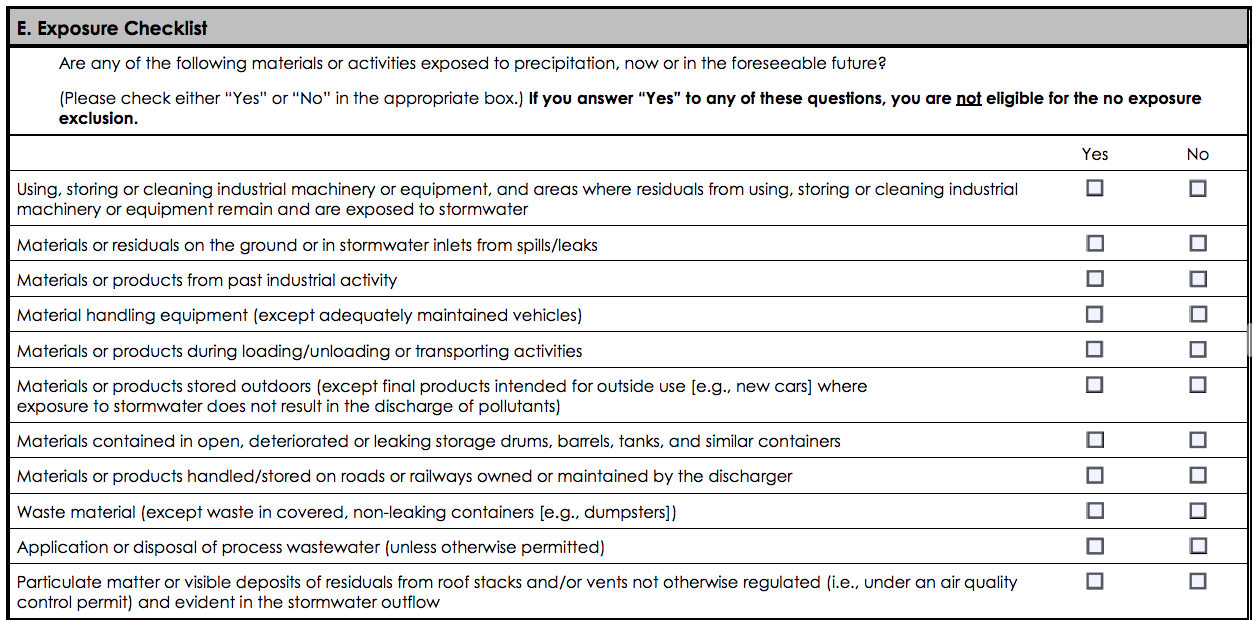Water from rain and melted snow washes dirt, oil, garbage and chemicals into nearby rivers and streams. This can be very hazardous to the health of these water channels and the land surrounding them. Keeping industrial materials in a storm-resistant shelter protects surrounding waterways from exposure to the potentially harmful effects of industrial stormwater runoff.
HISTORY
The No Exposure Certification (NEC) is an option under Federal & State Industrial Stormwater Permits, commonly referred to as Multi-Sector General Permits (MSGPs). The associated federal regulations were established during the 1987 Clean Water Act (CWA) Amendment. The goal of the permits is to implement sector-specific requirements to eliminate non-point sources of pollution. The NEC option is a significant benefit to industrial facilities, as it can eliminate these types of permit requirements while reducing overall environmental impact.
Non-point source pollution is caused by rainfall or snowmelt moving over and through the property of a facility while picking up industrial pollutants that are exposed outdoors. Common pollutants include suspended solids, oils & greases, pH, heavy metals, oxygen-demanding substances (organic materials), nutrients (phosphorus and nitrogen) and various types of toxins. Polluted stormwater runoff is a leading cause of impairment to the U.S. water bodies that do not meet water quality standards.
At the federal level, the EPA’s current MSGP became effective on June 4, 2015, and 29 industrial and commercial sectors apply to the permit. Most states have their own version of this permit and because they are all based on the EPA’s MSGP, the NEC requirements are very similar.
PERMITTING OPTIONS & NEC BENEFITS
MSGPs contain a list of Standard Industrial Codes (SIC) that apply to the permit. Once a facility has determined that their SIC code is applicable, they have two permitting options within the stormwater permit. These options are outlined below:
- Full Permit Coverage: The first option is to apply for full permit coverage that requires SWPPP development, Best Management Practices (BMPs), inspections, monitoring, reporting and employee training.
- NEC: The second option is to eliminate potential sources of pollution at a facility and submit an NEC. The NEC option eliminates most permitting requirements and only needs to be resubmitted every five years UNLESS exposure occurs at that site at any time during the 5-year term. If exposure occurs, full permit coverage is automatically needed.
NEC QUALIFICATIONS
For a facility to qualify for an NEC status, each facility must certify that there are NO industrial materials or activities exposed to precipitation at their site. To document the certification, each state’s NEC application contains the EPA’s “Exposure Checklist.” This checklist includes a list of materials and activities and requires the applicant to determine if any of these potential pollutants are exposed to stormwater at their facility by checking “yes” or “no.” The EPA’s Exposure Checklist is outlined on the following page:

Source: https://www.epa.gov/sites/production/files/2018-08/documents/msgp2015_appendixk_fillabler.pdf
As stated in the checklist, if “yes” is answered to any of the questions listed above, the facility is not eligible for an NEC.
PITFALL – EXPOSURE AFTER CERTIFICATION
If a facility has submitted an NEC and exposure occurs, agency enforcement is a real possibility. As a result, the facility would be required to obtain full permit coverage. Knowing this, most facilities that are aware of periodic exposure will choose full permit coverage. This allows flexibility within the outdoor operations and eliminates potential violations.
AGENCY INSPECTIONS
State agencies have come up with clever and efficient strategies to inspect a facility’s NEC status. Some states are actively reviewing aerial photos (available online), or simply driving by a facility to verify an NEC. There are even some states that require an onsite inspection after each NEC is submitted.
CONCLUSION
If your facility is claiming a No Exposure Certification, then you must ensure that the No Exposure status is (and always will be) continuously maintained. If not, full permit coverage should be considered to avoid violations and to increase flexibility at your site.



